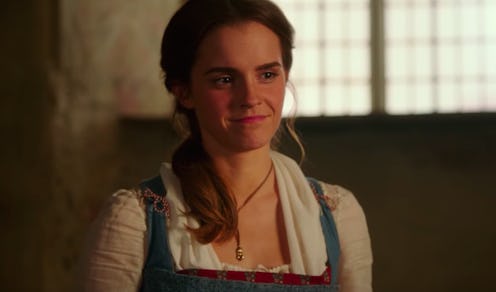
Disney's live action remake of Beauty & the Beast is just around the corner, and it's got fans of Disney everywhere experiencing some intense nostalgia after seeing Belle's iconic blue dress again. While Belle's yellow ball gown may be the star of the show, her blue frock from the film's beginning is notable not just for its iconic status but also for its color. In fact, the color blue is common among film heroine, and according to Allure, there's a specific reason for that and it's why — despite changes in texture and pattern — Emma Watson's Belle retained blue as the signature color of her first appearance onscreen.
There's little doubt that this year's Halloween will be filled with those wishing to embody Belle for their costume, and wearing a full, yellow ballgown may not be feasible. Thus, Belle's blue provincial frock comes to mind. According to Allure, the idea of Belle's blue relates back to the meaning of the color itself. Van Paris (Allure's writer) cites Leatrice Eiseman, the executive director of the Pantone Color Institute. Eiseman draws parallels between the dependability and reliability of the blue sky and how those qualities allows viewers to be drawn to the hue. Allure then connects the qualities of dependability and loyalty to their typical attribution to boys who will eventually become empowered men. Eiseman explains that by giving blue to female characters instead of male, it's a means of empowering them.
While Eiseman's assessment of Belle's signature blue is significant, it's costume designer Jacqueline Durran who explains the significance of Emma Watson's frock in the live action film. While fans of the former animated movie already knew that Watson's Belle would be more overtly feminist, the now utilitarian meaning of Belle's blue frock acts a signifier of this now more than it ever has.

While the blue may be a way to empower the heroine, it's the move toward a more functional costume that makes the most compelling argument for an empowered Belle. In the Allure article, Durran explains, "It is a practical color, and a color that you can work in. In that sense, it is full of active strength.” Here, it's hard to deny a connection between the blue of Belle's dress and the colloquialism of referring to laborers in more manual, active jobs as blue collar. Those active occupations draw parallels to Belle active, adventurous nature in the initial film.
The dress, however, has obviously changed since its first appearance in the animated film. Durran explains that the addition of bloomers for more movement was popular with Watson. My favorite addition that Durran spoke of, however, was the creation of pockets that Watson's Belle could easily access. According to the costume designer, women in eighteenth century France had pockets tied with strings beneath their dresses that they could access through a slit. Of course, as Belle is the active heroine, Durran chose to place the pockets on the outside of the new frock.
The reasons for Belle's blue dress may be subjective with many drawing parallels between the story's French setting and the classic hue of French Blue or the connection to innocence and purity via the traditional portrayal of the Virgin Mary in blue, the utilitarian, active intention Durran's costume is my favorite. Belle has generally been cited as one of the more feminist Disney heroines, and by crafting a costume that reflects an active, role-defying heroine, Durran only solidifies Belle's new place as a feminist heroine.